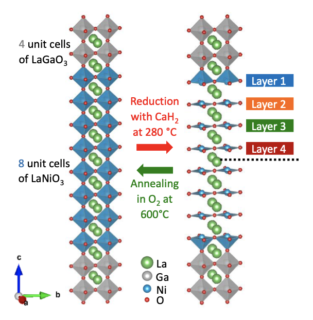A superlattice approach to doping infinite-layer nickelates
The recent observation of superconductivity in Sr-doped infinite-layer NdNiO2 thin films has attracted a lot of attention, since this compound is electronically and structurally analogous to the high-Tc superconducting cuprates. Since phase stabilization upon chemical doping with Sr is challenging, we synthesized artificial superlattices of LaNiO3 embedded in insulating LaGaO3, and used layer-selective topotactic reactions to reduce the nickelate layers to LaNiO2. Hole doping is achieved via interfacial oxygen atoms and the layer thickness. We used electrical transport measurements and x-ray spectroscopy together with ab initio calculations to track changes in the local nickel electronic configuration upon reduction and found that these changes are reversible. Experimental and theoretical data indicate that the doped holes are trapped at the interfacial quadratic pyramidal Ni sites, which then form the stable Ni2+ valence state. Calculations for electron-doped cases predict a different behavior, with evenly distributed electrons among the layers, thus opening up interesting perspectives for interfacial doping of transition metal oxides.
Link to Preprint: https://arxiv.org/abs/2102.05621

